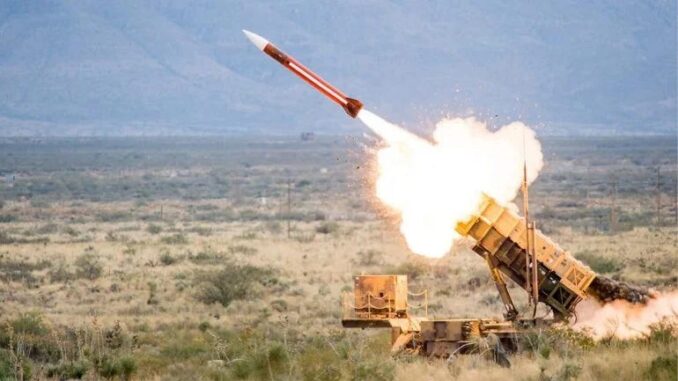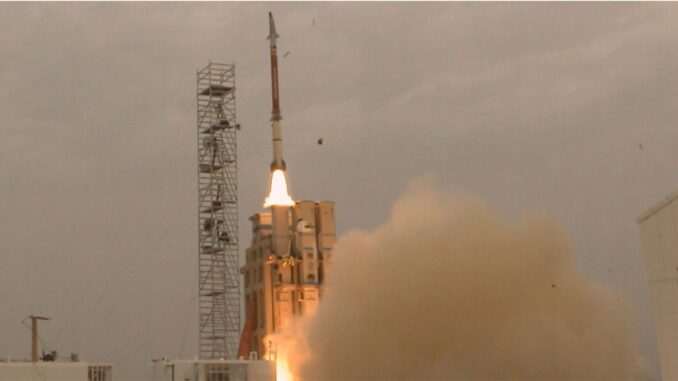It is unlikely Israel’s Patriots will head for the Scrap Heap
Stephen Bryen, Weapons and Strategy Substack May 1, 2024

GEM-T Missile Launch
While Europe is in the process of setting up a production line to manufacture GEM-T missiles for European Patriot batteries, Israel has decided to take its Patriot systems out of service. Do the Israelis know something the Europeans do not?
The GEM-T, or Guidance-enhanced tactical missiles, are part of the Patriot PAC-2 air defense system. This missile can intercept aircraft, drones,helicopters and some tactical missiles. It may be able to hit glide bombs like the ones being used by the Russians in Ukraine.
GEM-T uses a blast fragmentation warhead and the plus version features an improved fuse to more effectively engage threats.
GEM-T has a range of 70 km (43.5 miles) and can make intercepts at a height up to 24 km (15 miles).
In the recent Iranian attack against Israel, Israeli Patriot batteries are credited with nine shootdowns. Israel has not specified what was intercepted.
Israel got its original Patriot batteries in 1991. The systems, called Yahalom in Hebrew, are operated by Israel’s 138th Battalion. The systems have been modified over the years.
Since 2022 European countries have been ordering GEM-2 interceptors, initially from Raytheon (now called RTX). Recently an existing joint venture called COMLOG, half owned by RTX and the other half by MBDA, is investing in starting a new production line for GEM-T interceptors, mainly in Germany. The initial customers will be Romania, Netherlands, Spain and Germany. The four customers will purchase up to 1,000 missiles from this source and additional missiles from the United States. RTX currently produces around 20 missiles per month and is ramping up to 30 per month by 2027. Even with COMLOG, it will take years to fulfill the missile orders.
There are at least four other European customers for GEM-2 including Italy and many foreign customers including Korea, Japan, Saudi Arabia and the UAE.
Patriot systems can be roughly divided into two types: PAC-2 and PAC-3 although some PAC-2 Patriot systems have been upgraded so they can fire PAC 3 interceptors. In 2011 Israel announced it was upgrading its PAC-2 launchers to support PAC-3 interceptors. It is not clear if these upgrades took place as Israel’s home-built air defense systems were given priority. Israel also invested heavily, partnered with RTX, in the development of the Tamir interceptor for Israel’s Iron Dome system, and Stunner for David’s Sling, which is a maneuverable two stage hit to kill interceptor. Later Israel and RTX developed SkyCeptor, a variant of the hit to kill Stunner that can be used by Patriot batteries and will probably be the interceptor missile for PAC-4. According to the Pentagon, SkyCeptor is far less expensive than the MSE interceptor used by PAC-3.
 David’s Sling Launch
David’s Sling Launch
Israel has locally developed a highly integrated air defense network which includes Iron Dome, David’s Sling, Arrow 2 and Arrow 3. It is unlikely that Israel integrated its Patriots into its overall network. One deployment of Patriot, to Eilat in Israel’s south, was sent there to deal with Houthi-launched cruise missiles. That deployment suggests that Patriot was outside of the integrated air defense network.
Israel says that the PAC-2 system was hard to maintain and very expensive compared to local alternatives. While not directly criticizing either PAC-2 or GEM-T, some Israelis suggested that the system was not very effective against various missile threats.
Some have suggested Israel supply its Patriot batteries to Ukraine. While that is unlikely, assuming that the GEM-T interceptors are in good shape, they could be sold to foreign customers (although all sales would require US approval). Such sales could free up new production GEM-T missiles for delivery to Ukraine. Israel plans to decommission its Patriot batteries by the end of June, meaning that these missiles could easily find homes elsewhere in the near term. Israel also could supply its GEM-T missiles to “local” customers including Saudi Arabia and the UAE. Another possibility would be to transfer Israeli Patriot batteries to Jordan to bolster Jordan’s air defenses. Jordan supported Israel by shooting down a number of drones headed for Israeli territory during Iran’s attack on Israel on April 13th.
It would be surprising to find that Israel has not already lined up customers for its Patriot batteries and GEM-T interceptors.
Israel’s networked air defense system has features that PAC-2 lacks including more sophisticated command and control, more advanced radars, far better onboard sensors on Stunner and other missiles, and ability to locate where threats originate. Even so, PAC-2 with GEM-T remains a capable interceptor although the system does not fit well into Israel’s evolved air defense complex. In Europe where air defenses are not yet integrated and where interceptor stocks are low, the retired Israeli systems can still play a useful role. Europe has a long way to go before it has adequate air defense capabilities.
Thus it is unlikely Israel’s Patriots will head to the scrap heap.



Leave a Reply
You must be logged in to post a comment.